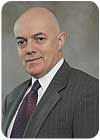
Alan Calegari, Ph.D., is the new president and CEO of digital video recorder manufacturer Dedicated Micros, Chantilly, Va. He spoke with SDM recently about his vision for integrating video surveillance with other types of security systems, the need for open standards and the rise of non-security applications of video surveillance.
SDM: You have said that integration can only occur when you have interoperability. Tell me what you mean by that.
Calegari:We have defined interoperability as the ability of the software and hardware of machines from different vendors to share data. When you have achieved that interoperability, the next step is integration, which we define as the ability for one device or software to be operated by another.
SDM: How have you been pushing for open standards in your product?
Calegari:We don’t operate yet in an open standard environment because there isn’t yet an open vendor environment in the security industry. Open standards will exist when you can replace one vendor’s video equipment with another’s with minimal changes. We heighten that ability with our NetVu Connected technology. Our equipment interoperates with each other. And with strategic partnering integration initiatives, we can do the same with the products of other vendors. We’re trying to reach a level of interoperability that’s the preliminary step to open standards.
SDM: What are the advantages of that strategy?
Calegari:The advantage is that our software development kit allows us to integrate with the widest range of partners while working with the industry to the highest standards. In the past, the security industry has suffered from a lack of standards.
SDM: How can you achieve differentiation in an open standards environment?
Calegari:Open standards specify how you perform basic functions and communicate with other systems. But they always allow vendors to provide additional information. Some good examples of an open standards environment are Wi-Fi access points or USB memory sticks. If you look at Wi-Fi applications, you can still achieve differentiation by customizing the open standards to specific requirements driven by a customer or market requirement.

Alan Calegari
Calegari:What we do is not just give developers the basic elements for them to connect the systems. We really open our system to create total interoperability, which is critical. There can’t be real integration unless systems are truly interoperable and can function with fluid requirements.
The requirement is to bring the customer a fully integrated security solution that is greater than the sum of the stand-alone products. We don’t fear infringement or loss of intellectual property by opening up to quality vendors because as we open up more, we enhance trust in our partners and customers.
SDM: You have also made the comment that security is more than crime prevention. What other things does security entail?
Calegari:Risk management is an application that industries are looking to apply to various aspects of their business. Today, we see video surveillance used for safety and adherence to safety policy, in warehousing and transportation, to minimize lawsuits.
In the U.S., on average, there are $7 trillion in lawsuits a year. The application of video surveillance can be used in a court of law or can prevent going to a court of law.
Think about pharmaceuticals when they use batch control. The only way you can determine that a batch was done under strict controls is to turn cameras on and have an overriding message with the date.
SDM: What new types of integration do you see a demand for?
Calegari:We developed an ATM system with evidentiary markings, and you can expand that with an emergency message system. The trend with fraud is to hit many locations in a certain amount of time.
This system enables video footage to be sent to various bank offices with an image of the culprit. Then you have to layer in analytics to detect potential masquerading of individuals.
Fraudulent checks can be put on video and circulated to other divisions.



